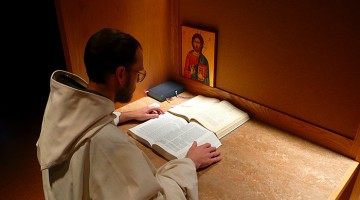Theory
In the Christian tradition, the reading of Scripture has particular importance. From the early Church, the reading of Scripture went beyond simply comprehending the ideas contained within the Bible, but rather was considered an integral part of entering into the Divine communion. Reading led to dialogue with God, a dialogue in which the full faculties of the intellect were engaged in a quest to enter into the Divine mysteries.
The four senses of scripture were a systematic representation of the way in which the Church Fathers allowed Scripture to awaken within them the Holy Spirit. The Church Fathers used the full palette of their conceptual learning and their imaginative ponderings to explore the sacred text with a sense of wonder and awe. An attitude of reverence for the sacredness of Scripture was also combined with a sense of play and ease. The Church Fathers were not afraid to explore different avenues of intuition, all of which were the fruit of fidelity to the Church and intense study.
Our study of Sacred Scripture should lead us to ponder the Word of God with the same creativity and curiosity showed by the Church Fathers. Methods of lectio divina (i.e. meditating on the Scripture) should not shackle this sense of play, but rather help us to enter into the more spontaneous promptings of the Spirit. Often, methods of prayer arose from a saint trying to teach those who came after him or her ways of entering into what they discovered by trial and error. The danger is often that when we apply their suggestions, we don’t allow ourselves the freedom that the saint is trying to convey.
The practice of lectio divina is not supposed to be a series of steps and stages that we must meticulously follow like the recipe for baking a cake. Rather, they are a gentle guide that helps us to become aware of the basic contours of meditation. Again, methods are preliminary and can be abandoned at the discretion of the believer. They are only meant to point the way.
Practice
The tradition distinguishes between four steps of lectio divina. This was a later development that was an attempt to systematize the practices of monks so that it could be faithfully transmitted across generations.
The first step is lectio or reading. The idea is simple enough, you must begin by reading the text and discerning what is its most basic meaning, also called the literal sense. This should not be confused with literalism. This kind of reading of Sacred Scripture fails to take into consideration the context in which the Scripture was written. In contrast, the Catholic tradition talks about the literal sense which is how the Holy Spirit worked through the human author’s intent. For the sake of meditation, if a particular passage is difficult or confusing, the believer has two options. They can simply move on to something that makes more sense, or they can do more research and try to discover what the Sacred Author intends.
Once a person has a decent grasp of the literal sense, then one can allow the Word to become the content of their meditation (meditatio). You might notice that there is an overlap with the previous four step method, and that is okay. It might seem a little confusing at first, but both lectio divina and the method of meditation previously discussed neatly complement and work well together. For the sake of this presentation, it suffices to say that meditation in this section simply refers to the active pondering of what one has read.
The third step is called oratio or prayer. Similar to the previous method, the meditation naturally flows into a dialogue with Jesus Christ. We respond to the Word and allow the Spirit to speak within us. One step moves to the next and then back again. We should not feel constrained, but rather allow the Spirit to move us from meditation to prayer and back again.
As we move back and forth between meditation and prayer, we come to a point where the mind simply desires to rest. Instead of trying to force our intellects into active meditation, we also gain a sensitivity to the art of letting our minds rest in the Word. The tradition calls this resting in the Word contemplation, and there are many resources that teach about contemplation. For the sake of this section, it is important to note that this resting is not an act of the will, but a gift from God that is to be received with gratitude.
In the end, contemplation teaches us that prayer is not doing. Prayer is a reality that goes beyond our subjective awareness, and in time we learn to let go of our constant need to do and to know. This letting go, which is a work of the Holy Spirit, allows us to enter into the wordless, imageless gaze of contemplation.[1]
[1] Taken from the Catechism.












No Comment